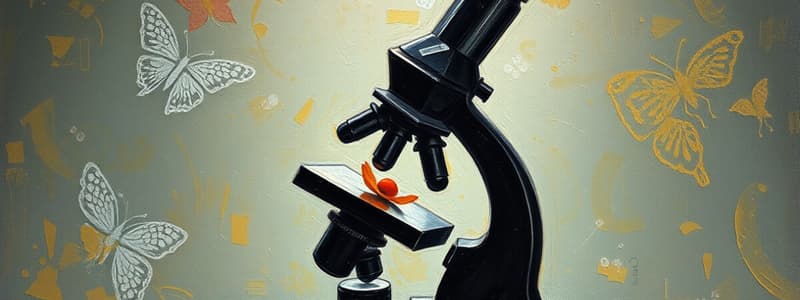Podcast
Questions and Answers
What is the minimum distance that the unaided eye can separate objects?
What is the minimum distance that the unaided eye can separate objects?
- 0.01-0.1 mm
- 1-2 mm
- 0.5-1 mm
- 0.10-0.15 mm (correct)
Which part of the microscope is designed for placing slides during observation?
Which part of the microscope is designed for placing slides during observation?
- Eyepiece
- Base
- Objective Lens
- Stage (correct)
What should you do to avoid damage to the objective lens while using a microscope?
What should you do to avoid damage to the objective lens while using a microscope?
- Remove the lens frequently to inspect it
- Lower the lens until it touches the slide
- Keep the lens from touching the slide (correct)
- Clean the lens with a rough cloth
How should one ideally carry a microscope?
How should one ideally carry a microscope?
Which of the following is a proper practice for maintaining microscopes?
Which of the following is a proper practice for maintaining microscopes?
What should be avoided when storing a microscope to prevent damage?
What should be avoided when storing a microscope to prevent damage?
Which of these components needs to be kept dust-free?
Which of these components needs to be kept dust-free?
What is a common cause of problems with microscopes?
What is a common cause of problems with microscopes?
What is the purpose of oil immersion in microscopy?
What is the purpose of oil immersion in microscopy?
Which action is recommended for extending the life of the microscope bulb?
Which action is recommended for extending the life of the microscope bulb?
What should you use to clean the microscope lenses?
What should you use to clean the microscope lenses?
Why is it important to refer to the user’s manual when making adjustments to a microscope?
Why is it important to refer to the user’s manual when making adjustments to a microscope?
What maintenance task is recommended at least once a year for microscopes?
What maintenance task is recommended at least once a year for microscopes?
What should be avoided when making adjustments to a microscope?
What should be avoided when making adjustments to a microscope?
Why might one consider contacting the company where the microscope was purchased?
Why might one consider contacting the company where the microscope was purchased?
What aspect of microscope lenses should be treated with care?
What aspect of microscope lenses should be treated with care?
What is the primary function of the condenser in a microscope?
What is the primary function of the condenser in a microscope?
How do you calculate the total magnification of a microscope?
How do you calculate the total magnification of a microscope?
What happens to the field of view as magnification increases?
What happens to the field of view as magnification increases?
What is the thickness range of microscope slides?
What is the thickness range of microscope slides?
Which of the following is NOT a mechanical part of the microscope?
Which of the following is NOT a mechanical part of the microscope?
If the diameter of the field of view at 100x magnification is 1.78 mm, what is the diameter at 1000x magnification?
If the diameter of the field of view at 100x magnification is 1.78 mm, what is the diameter at 1000x magnification?
What is the purpose of the diaphragm in a microscope?
What is the purpose of the diaphragm in a microscope?
Which component is classified as an illuminating part of the microscope?
Which component is classified as an illuminating part of the microscope?
What is the purpose of a cover slip on a microscopic slide?
What is the purpose of a cover slip on a microscopic slide?
What is the first step in the wet mounting technique?
What is the first step in the wet mounting technique?
Which method of slide preparation requires very fine slices for optimal viewing?
Which method of slide preparation requires very fine slices for optimal viewing?
Which of the following staining solutions can be used on both wet and dry mounts?
Which of the following staining solutions can be used on both wet and dry mounts?
What adjustment should be made after placing the slide on the mechanical stage?
What adjustment should be made after placing the slide on the mechanical stage?
What should be done to avoid air bubbles while placing a cover slip?
What should be done to avoid air bubbles while placing a cover slip?
How can you ensure that the microscope is set up correctly before usage?
How can you ensure that the microscope is set up correctly before usage?
What is the purpose of adjusting the condenser in microscopy?
What is the purpose of adjusting the condenser in microscopy?
What is the primary function of the eyepiece lens in a microscope?
What is the primary function of the eyepiece lens in a microscope?
Which part of the microscope prevents the objective lenses from getting too close to the slide?
Which part of the microscope prevents the objective lenses from getting too close to the slide?
What range of magnification does the eyepiece lens typically provide?
What range of magnification does the eyepiece lens typically provide?
Which part of the microscope is responsible for providing stability and support?
Which part of the microscope is responsible for providing stability and support?
What feature do some microscopes have that allows for more precise positioning of slides?
What feature do some microscopes have that allows for more precise positioning of slides?
What type of light source can the microscope illuminator provide?
What type of light source can the microscope illuminator provide?
Which objective lens is classified as the scanning lens?
Which objective lens is classified as the scanning lens?
What is the purpose of the control focus knobs on a microscope?
What is the purpose of the control focus knobs on a microscope?
Flashcards are hidden until you start studying
Study Notes
Microscopy Overview
- Microscopy refers to using microscopes to examine specimens at a high level of detail, essential for biological, pharmaceutical, and scientific studies.
- The human eye can resolve objects approximately 0.10-0.15 mm apart.
Learning Outcomes
- Proper handling and usage of microscopes.
- Identification and function of microscope parts.
- Techniques for mounting specimens on slides.
- Ability to focus on and capture quality images of specimens.
Proper Care and Maintenance of Microscopes
- Handle microscopes carefully, using the base and support arm to avoid misalignment.
- Avoid letting objective lenses touch slides to prevent damage.
- Always cover microscopes with dust covers during storage and transport to keep them clean.
- Store in a clean, dry, well-ventilated space, away from corrosive chemicals or moisture.
- Use oil immersion to enhance resolution while cleaning and maintaining lenses.
- Turn off and cool down bulbs after use to prolong lifespan.
- Clean lenses gently with appropriate materials; never use abrasive substances.
- Refer to the user’s manual for adjustments and maintenance; avoid forceful handling.
- Annual maintenance checks are recommended for moving parts and safety inspections.
- Seek professional servicing for comprehensive upkeep.
Parts of the Microscope
- Eyepiece Lens: Contains the ocular lens; common magnifications are 10X or 15X.
- Eyepiece Tube: Connects the eyepiece to objective lenses.
- Microscope Arm: Connects the eyepiece tube to the microscope base.
- Base: Provides stability and houses the light source.
- Illuminator: Light source via built-in or reflective mirrors.
- Stage and Stage Clips: Holds slides in place; mechanical stages allow for slide adjustment.
- Nosepiece: Rotates to switch between objective lenses.
- Objective Lenses: Increase magnification; includes scanning (4X), low power (10X), high power (40X), and oil immersion (100X).
- Rack Stop: Prevents objective lenses from damaging slides.
- Control Focus Knobs: Adjust the focus; coarse for initial and fine for precise adjustments.
- Condenser Lens and Diaphragm: Concentrate and regulate light on the specimen.
Magnification and Field of View
- Calculate magnification by multiplying ocular (10X) by objective lens.
- Common maximum magnifications: 40X, 100X, 400X, and 1000X.
- The field of view decreases with increased magnification; diameter changes with different objectives.
- For example, if the diameter at 100X is 1.78 mm, it would be 0.178 mm at 1000X.
Mounting Specimens on Slides
- Slides are typically 1x3 inches and made of glass or plastic.
- Cover Slips: Hold samples and protect against contamination.
- Dry Mount Technique: Place thin slices on slides and cover with a slip.
- Wet Mount Technique: Use liquid to hydrate samples and create a proper viewing context.
- Staining: Enhances visibility of details; can apply staining solutions to both dry and wet mounts.
Focusing Images Under a Microscope
- Position the microscope on a stable surface with the arm facing the user.
- Turn on the light and adjust settings for optimal brightness.
- Start with the lowest power objective lens before placing slides.
- Use the focus knobs to bring the sample into view; adjust the condenser for sufficient light.
- Center the specimen in the field of view for detailed observation.
Studying That Suits You
Use AI to generate personalized quizzes and flashcards to suit your learning preferences.




